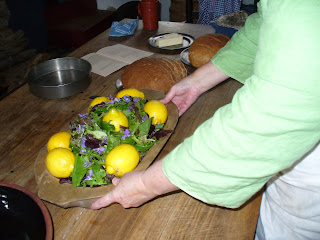The first thing you see in Chinatown is the Friendship Gate, built in 1984 to celebrate an agreement with Tianjin, a city in China, which is considered to be Chinatown's sister city.
There are a lot of street vendors and shops that sell traditional Chinese goods. We visited a fish market, where the fish were very fresh as well as a Chinese grocery store. Something that intrigued us was "Tea Eggs" sold on the street by a vendor. We were told that tea eggs are very popular in China and that they are sold by vendors as well as fast food chains there. They smelled very delicious and the marbling color of the eggs would make a very pretty party dish. A recipe can be found here: Asian-Fusion Recipes. I have yet to try one but they look great.

We saw lots of produce stands, many which included exotic fruits and vegetables including Durian, a spiky fruit that supposedly tastes delicious but smells really bad. It is also said to be the worlds most dangerous fruit. We also saw starfruit, which when you cut it open makes perfect star shaped fruit. This seems like it could have endless uses by a competent cook.
There were a lot of traditional Chinese restaurants, we ate Dim Sum, small portions of a lot of different kinds of food which you share with others, at a restaurant called Joy Tsin Lau ( Mansion of the Drunken Immortal.) Everything was very flavorful and the experience of everyone splitting all of the food and trying new things was fantastic. We even went to visit a Fortune Cookie Factory. (Those are boxes of fortunes in the picture.)

This plaque commemorates the beginning of Chinatown in 1845! It is still going strong after 165 years.
The trip was a very fun experience. I would recommend it. We took the train as it is chaotic and expensive to park in Philadelphia. If you do decide to go, be sure to take a map. It is very easy to get turned around and many of the interesting shops are down back alleys. It was a very fun trip.





















